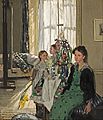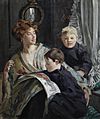Hilda Fearon facts for kids
Hilda Fearon (1878–1917) was a talented British artist. She was known for her beautiful paintings and was part of a group of artists called the St Ives School.
Contents
Early Life and Art Studies
Hilda Fearon was born in 1878 in Banstead, a town in Surrey, England. She was the third daughter of Paul Bradshaw Fearon, who was a wine and spirits merchant.
When she was a young woman, Hilda left Banstead to study art. She first studied in Dresden, Germany, from 1897 to 1899 with an artist named Robert Sterl. After that, she attended the famous Slade School in London from 1899 to 1904. She also studied with artist Algernon Talmage in St Ives, Cornwall, a popular place for artists.
Her Art and Exhibitions
Hilda Fearon started to become well-known as a member of the St Ives School. This group of artists liked to paint outdoors, a style called "plein air." Her work was shown in St Ives and Cheltenham in 1906. Some of her early paintings included The End of the Evening and Moonlit Harbour.
Even though she continued to paint landscapes and scenes of beaches and the sea, her art also changed. She began to paint many different subjects. Hilda often showed women and children inside buildings in her paintings.
Her painting The Song was shown at the Royal Academy in 1909. Critics described it as a "small but very admirable" group portrait. One critic from the Daily News said it was "admirable in tone" and "interesting." They also noted that Fearon "appears... to have something to say."
Hilda's paintings were shown regularly in the years before she passed away. Her art was displayed at many places, including the Royal Institute of Painters in Water-Colours in London and the Royal Academy of Arts. She showed paintings like Willows (1908), The White Room (1910), The Ballet Master (1912), and The Breakfast Table (1916).
Last Exhibition and Passing
In 1917, Hilda Fearon's paintings were again shown at the Royal Academy. These paintings, Afternoon Sunshine and The Road Across the Downs, showed people in outdoor scenes. One critic said they were "things seen and felt." Afternoon Sunshine showed two children playing with a goat in the sun. The Road Across the Downs showed a lady in a cart on a white road.
These paintings were described as "very delightful" and helped her reputation grow. Sadly, Hilda Fearon passed away on June 2, 1917, at the age of 38.
Where Her Art Is Kept
Today, Hilda Fearon's artwork can be found in important art collections. Her paintings are part of the Tate Gallery in London and the Art Gallery of South Australia.
Gallery
See also
 In Spanish: Hilda Fearon para niños
In Spanish: Hilda Fearon para niños





